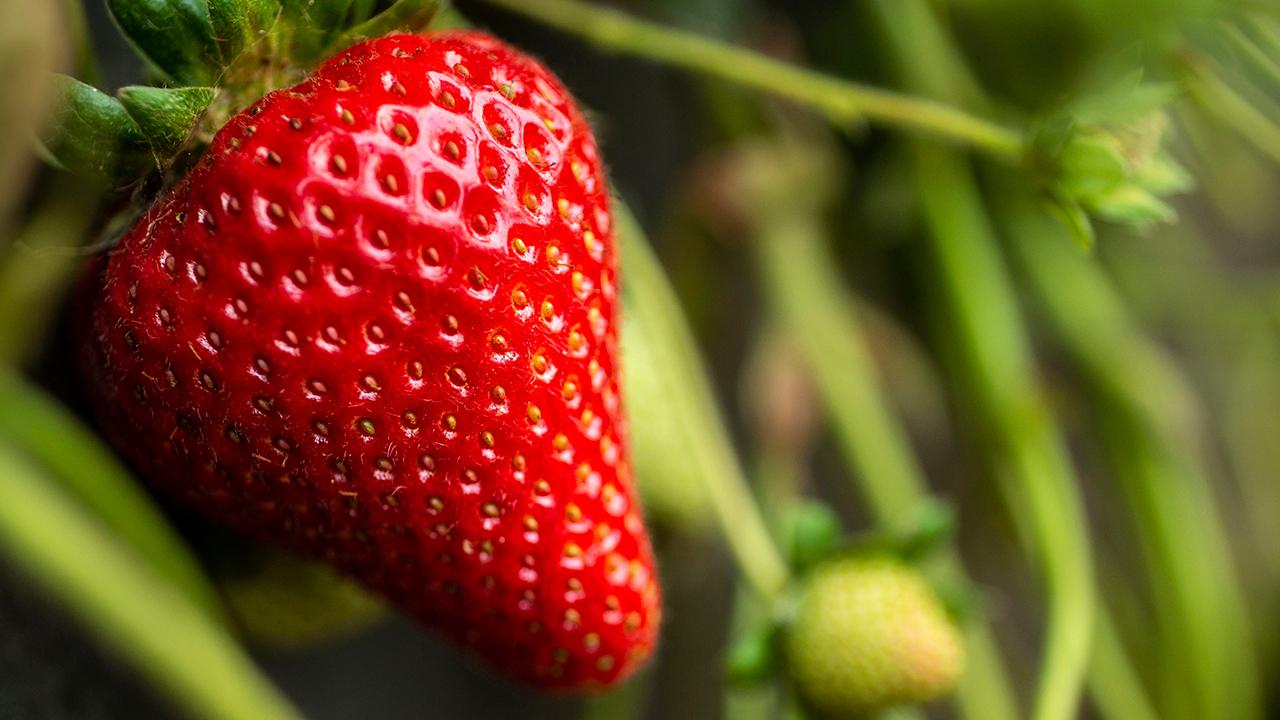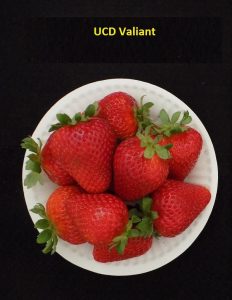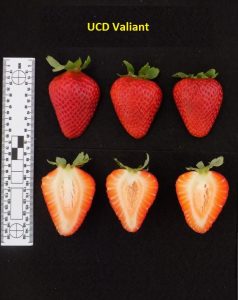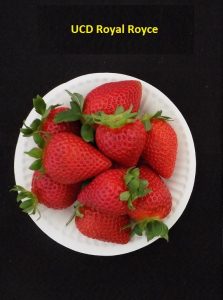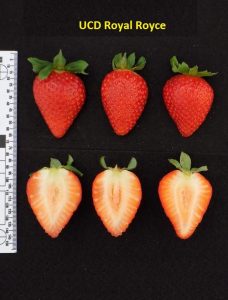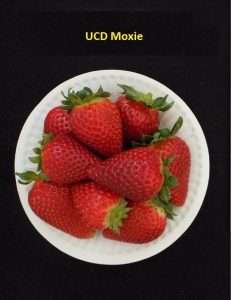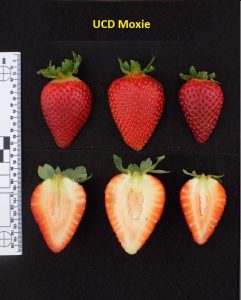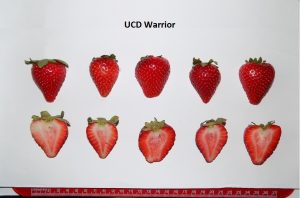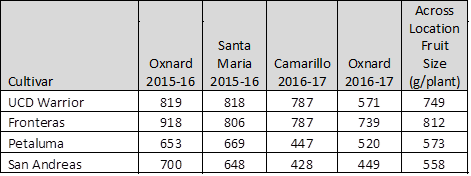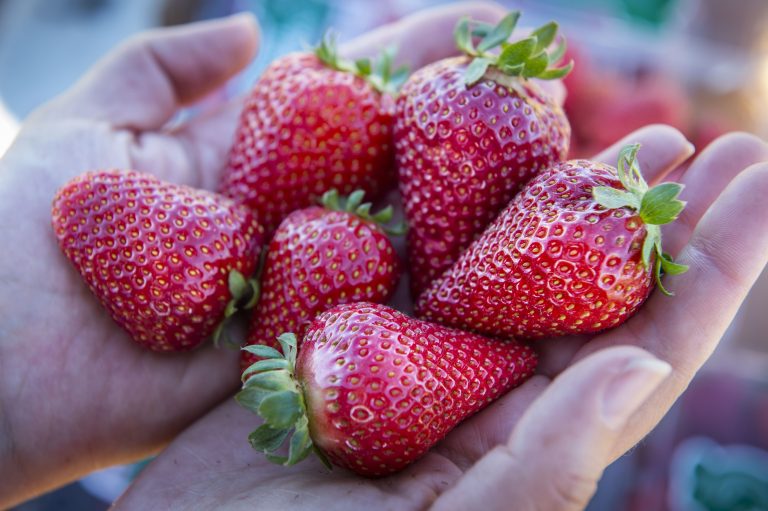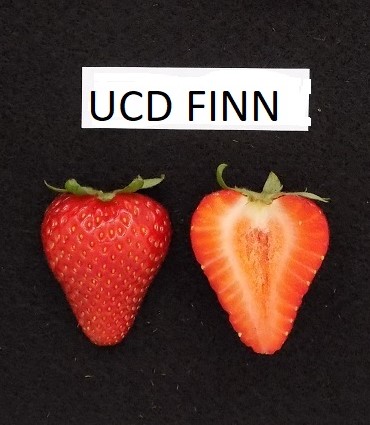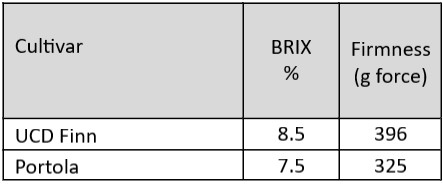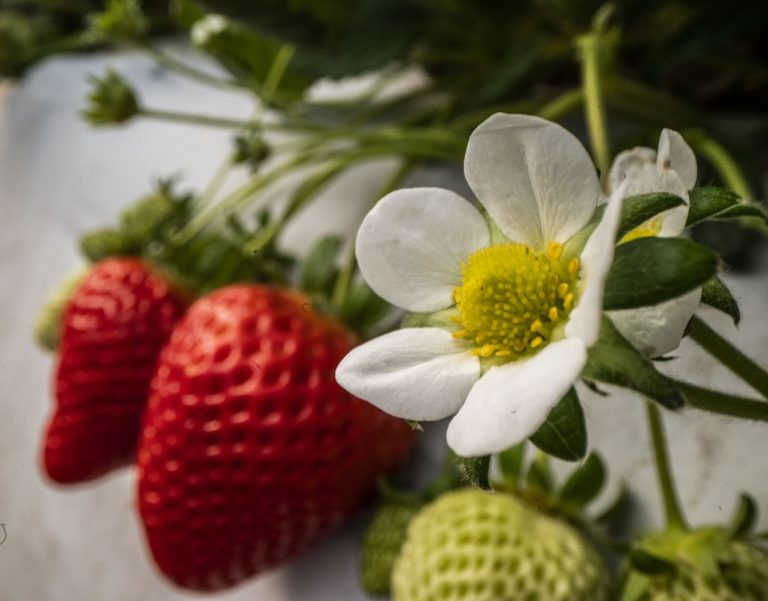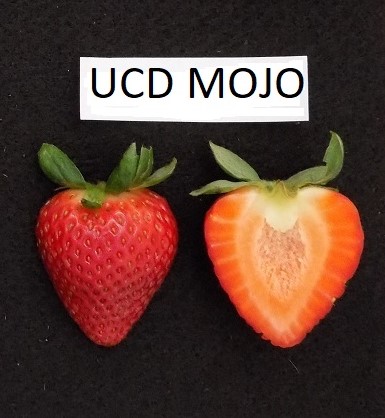Strawberry Licensing Program
Licensing Strawberry Varieties
License Agreement Information
Propagate, transfer, or use UC varieties for research purposes by obtaining a license request form. Note: Fruit producers do not need a license.
The UC Patented Strawberry Cultivars
Working together to advance and deploy UC-developed cultivars in diverse national and international markets.
Day Neutral Varieties
UC Keystone (New)
UC Keystone
This is a new day neutral cultivar from the UC Davis Strawberry breeding program. The initial breeding cross originated in 2017 and the selection 17C138P062 was made. It was subsequently tested as that number from 2019-2022. This cultivar is a mid to late-season day neutral variety with excellent post–harvest qualities.
UC Keystone produces equal to higher yields and % marketable fruit relative to UC’s four main commercial day neutral cultivars (Monterey, Cabrillo, UCD Royal Royce, & UCD Valiant). Those four cultivars are all susceptible to Fusarium wilt whereas UC Keystone is resistant. It performs best in fall planted production systems, and it performs equally well when harvested with 400-600 chilling hours from high elevation nurseries and planted directly with no post-harvest chill versus plants given 10-17 days post -harvest chill. Fruit is firm which supports better post -harvest keeping qualities.
UC Keystone is resistant to Fusarium wilt (Fusarium oxysporum), moderately resistant to Verticillium wilt (Verticillium dahlia) and Phytophthora crown rot (Phytophthora cactorum), and moderately susceptible to Charcoal rot (Macrophomina phaseolina).
Nursery clone productivity for UC Keystone is equal or superior to that of Monterey, a well-known day neutral cultivar as a comparison.
Click on the following link for more disease information and photos of UC Keystone UC Keystone Cultivar
Commercial Availability
Strawberry producers can obtain UC Keystone from commercial nurseries licensed by the University of California. See Licensed Nurseries List.
UC Golden Gate (New)
UC Golden Gate Cultivar
This is a new day neutral cultivar from the UC Davis Strawberry breeding program. The initial breeding cross originated in 2017 and the selection 17C139P045 was made. It was subsequently tested as that number from 2019-2022. This cultivar is an early to mid-season day neutral variety with excellent post- harvest qualities.
UC Golden Gate produces equal to higher yields and % marketable fruit relative to UC’s four main commercial day neutral cultivars (Monterey, Cabrillo, UCD Royal Royce, & UCD Valiant). Those four cultivars are all susceptible to Fusarium wilt whereas UC Golden Gate is resistant. It performs best in fall planted production systems, but performs equally well when harvested with 400-600 chilling hours from high elevation nurseries and planted directly with no post-harvest chill versus plants given 10-17 days post-harvest chill. Fruit is firm which supports better post -harvest keeping qualities.
UC Golden Gate is resistant to Fusarium wilt (Fusarium oxysporum), moderately resistant to Verticillium wilt (Verticillium dahlia) and Phytophthora crown rot (Phytophthora cactorum), and moderately susceptible to Charcoal rot (Macrophomina phaseolina).
Nursery productivity for UC Golden Gate is equal or superior to that of San Andreas a well-known day neutral cultivar as comparison.
Click on the following link for more disease information and photos of UC Golden Gate UC Golden Gate Cultivar
Commercial Availability
Strawberry producers can obtain UC Golden Gate from commercial nurseries licensed by the University of California. See Licensed Nurseries List.
UCD Valiant
The UCD Valiant Cultivar (PDF)
This is a new day neutral cultivar released from the UC Davis Strawberry breeding program. The initial breeding cross originated in 2011 and the selection 11C103P001 was made. It was subsequently tested as 16DN011 from 2016-2018. This cultivar is an early season day neutral variety that excels in the southernmost day neutral growing regions of California and in organic and lower input growing environments.
Valiant produces significantly higher yields and % marketable fruit relative to UC’s three main commercial day neutral cultivars (Cabrillo, Monterey and San Andreas). It performs best in fall planted production systems, but performs equally well when harvested with 400-600 chilling hours from high elevation nurseries and planted directly with no post harvest chill versus plants given 10-17 days post harvest chill. The plant is more vigorous in growth habit and the plant performs better in lower input growing environments producing larger fruit size. Fruit is firmer than the check commercial cultivars, which supports better post harvest keeping qualities.
Valiant is moderately resistant to Verticillium wilt (Verticillium dahlia), moderate susceptibility to Phytophthora crown rot (Phytophthora cactorum), and susceptible to Fusarium wilt (Fusarium oxysporum), and Charcoal rot (Macrophomina phaseolina).
Nursery productivity for Valiant is superior to that of San Andreas, a well known day neutral cultivar, as comparison.
Performance of Valiant in advanced trials in Santa Maria and Prunedale 2015-2017 (Yield in grams per plant harvested through early September)
Performance of Valiant in strip trials in 5 locations in 2018 (Yield in cartons per acre harvested through November)
Disease Reaction of Valiant in trials at UC Davis and Cal-Poly SLO 2016-2018
Fruit Quality Assessments in 5 locations in 2018
Commercial Availability
Strawberry producers can obtain UCD Valiant from commercial nurseries licensed by the University of California. See Licensed Nurseries List.
UCD Royal Royce
UCD Royal Royce Cultivar (PDF)
This is a new day neutral cultivar released from the UC Davis Strawberry breeding program. The initial breeding cross originated in 2008 and the selection 08C123P001 was made. It was subsequently tested as 16DN009 from 2016-2018. This cultivar is a early to mid-season day neutral variety with excellent post harvest qualities.
Royal Royce produces significantly higher yields and % marketable fruit relative to UC’s three main commercial day neutral cultivars (Cabrillo, Monterey and San Andreas). It performs best in fall planted production systems, but performs equally well when harvested with 400-600 chilling hours from high elevation nurseries and planted directly with no post harvest chill versus plants given 10-17 days post harvest chill. One critical advantage to Royal Royce is a significant reduction of runners during the berry growing season which results in a significant reduction in field production costs for growers who need to cut runners to manage for higher fruit yields. Fruit is firmer than the check commercial cultivars, which supports better post harvest keeping qualities.
Royal Royce is moderately resistant to Verticillium wilt (Verticillium dahlia) and has moderate susceptibility to Phytophthora crown rot (Phytophthora cactorum), Fusarium wilt (Fusarium oxysporum), and Charcoal rot (Macrophomina phaseolina).
Nursery productivity for Royal Royce is equal or superior to that of San Andreas a well known day neutral cultivar as comparison.
Performance of Royal Royce in advanced trials in Santa Maria and Prunedale 2015-2017 (Yield in grams per plant harvested through early September)
Performance of Royal Royce in strip trials in 5 locations in 2018 (Yield in cartons per acre harvested through November)
Disease Reaction of Royal Royce in trials at UC Davis and Cal-Poly SLO 2016-2018

Fruit Quality Assessments in 5 locations in 2018
Commercial Availability
Strawberry producers can obtain UCD Royal Royce from commercial nurseries licensed by the University of California. See Licensed Nurseries List.
UCD Moxie
The UCD Moxie Cultivar (PDF)
This is a new day neutral cultivar released from the UC Davis Strawberry breeding program. The initial breeding cross originated in 2011 and the selection 11C141P001 was made. It was subsequently tested as 16DN012 from 2016-2018. This cultivar is a full-season day neutral variety excelling as the season goes on with excellent post harvest qualities.
Moxie produces significantly higher yields and % marketable fruit relative to UC’s three main commercial day neutral cultivars (Cabrillo, Monterey and San Andreas).
It performs best in fall planted production systems, but performs equally well when harvested with 400-600 chilling hours from high elevation nurseries and planted directly with no post harvest chill versus plants given 10-17 days post harvest chill. Because of the ability of the cultivar to yield late into November/December under this culture system, it may fill a product niche as a competitor to Portola, which is grown in a summer plant system. One critical advantage to Moxie is a significant reduction of runners during the berry growing season which results in a significant reduction in field production costs for growers who need to cut runners to manage for higher fruit yields. Fruit is firmer than the check commercial cultivars, which supports better post harvest keeping qualities.
Moxie is resistant to Fusarium wilt (Fusarium oxysporum), moderately resistant to Verticillium wilt (Verticillium dahlia), moderate susceptibility to Phytophthora crown rot (Phytophthora cactorum) and and susceptible to Charcoal rot (Macrophomina phaseolina).
Nursery productivity for Moxie is equal to that of San Andreas a well known day neutral cultivar as comparison.
Performance of Moxie in advanced trials in Santa Maria and Prunedale 2015-2017 (Yield in grams per plant harvested through early September)
Performance of Moxie in strip trials in 5 locations in 2018 (Yield in cartons per acre harvested through November)
Disease Reaction of Moxie in trials at UC Davis and Cal-Poly SLO 2016-2018
Fruit Quality Assessments in 5 locations in 2018
Commercial Availability
Strawberry producers can obtain UCD Moxie from commercial nurseries licensed by the University of California. See Licensed Nurseries List.
Monterey
The Monterey Cultivar
Monterey is moderate in day-neutrality, slightly stronger flowering than Albion with a similar production pattern. It is a vigorous plant and may require slightly more space than Albion. The fruit for Monterey is slightly larger but less firm than for Albion. Post-harvest traits for Monterey are similar to those for Albion. Monterey has outstanding flavor with a distinct sweet aftertaste that is unique among California cultivars. Monterey has a good disease resistance profile, although it is susceptible to powdery mildew (Sphaerotheca macularis); this disease will require close control by both nursery and fruit growers in order to farm this cultivar successfully. Nursery productivity for Monterey is exceptional.
Performance of Aromas, Diamante, and Albion compared with Monterey, San Andreas, and Portola at the Watsonville Research Facility in 2005-2007
| Item | Yield (C/Acre) | Late Yield (C/Acre) | Appearance Score (5=best) | Fruit Size (g/fruit) | Firmness |
| Aromas |
9,495
|
2,401
|
3.1
|
27.6
|
9.5
|
| Diamante |
8,313
|
2,420
|
3.5
|
31.5
|
11.0
|
| Albion |
7,783
|
2,247
|
3.9
|
30.6
|
11.2
|
| Monterey |
10,554
|
3,062
|
3.4
|
32.6
|
10.8
|
| San Andreas |
10,414
|
3,238
|
4.4
|
30.8
|
11.6
|
| Portola |
10,335
|
3,324
|
3.6
|
31.5
|
10.2
|
Macdoel plants harvested 10-15, planted with 2.5-3.5 weeks storage (52″ 2-row beds, 17,300 plants/acre)
Commercial Availability
Strawberry producers can obtain Monterey from commercial nurseries licensed by the University of California. See Licensed Nurseries List.
Cabrillo
The Cabrillo Cultivar
The Strawberry Breeding program at UC Davis has released a new day-neutral cultivar originating from a cross performed in 2008: Cabrillo, formerly identified as CN236 and originally referenced as Cal 8.181-1. This cultivar exhibits uniformly high productivity, greater than for San Andreas and Monterey, and is adapted to standard fall planting and winter production systems, as well as to spring and summer planting. This cultivar has overall fruit quality equal or superior to presently available day-neutral cultivars.
Cabrillo has slightly larger fruit and produces greater individual-plant yield than any of the comparison cultivars. It has a similar production pattern to Albion with most cultural treatments, although it is substantially more adapted to later-season winter planting and spring planting. Commercial appearance ratings have been similar to or better than those for all of the comparison cultivars, especially better than Portola in summer planting systems; these superior appearance scores translate directly into a larger fraction of marketable fruit than is produced by the comparison cultivars. Fruit for Cabrillo is firmer than fruit from the comparison cultivars. Subjectively, Cabrillo has outstanding flavor.
Cabrillo is moderately resistant to powdery mildew (Sphaerotheca macularis), and moderately susceptible to Anthracnose crown rot (Colletotrichum acutatum). It is moderately resistant to Verticillium wilt (Verticillium dahliae), Phytophthora crown rot (Phytophthora cactorum) and common leaf spot (Ramularia tulasnei). When treated properly, it has tolerance to two-spotted spider mites (Tetranychus urticae) equal to that for the comparison cultivars. Nursery productivity for Cabrillo is equal or superior to that for existing day-neutral cultivars.
Performance of Cabrillo compared with Three DN Selections at the Watsonville Research Facility in 2012 – 2013
| Item | Yield
(C/Acre) |
Appearance
Score (5=best) |
Fruit
Size (g/fruit) |
Firmness |
| ‘Albion’ | 8,325 | 4.1 | 32.6 | 12.2 |
| ‘San Andreas’ | 9,774 | 4.3 | 32.0 | 12.2 |
| ‘Portola’ | 9,172 | 3.4 | 31.7 | 11.4 |
| ‘Cabrillo’ (CN236) | 11,605 | 4.3 | 32.0 | 12.2 |
Macdoel plants harvested 10-15, planted with 2.5 weeks storage
(52″ 2-row beds, 17,300 plants/acre)
Commercial Availability
Strawberry producers can obtain Cabrillo from commercial nurseries licensed by the University of California. See Licensed Nurseries List.
Albion
The Albion Cultivar
Albion is a Day-neutral (ever-bearing) cultivar similar to Diamante. Fruiting plants of Albion are similar in size and vigor to Diamante, but more open, and more erect than plants of Diamante. Nursery source, chilling requirements, and planting dates should be very similar for Albion and Diamante.
Albion is quite resistant to Verticillium wilt (Verticillium dahliae) and Phytophthora crown rot (Phytophthora cactorum), and relatively resistant to Anthracnose crown rot (Colletotrichum acutatum). When treated properly, it has tolerance to two-spotted spider mites (Tetranychus urticae) equal or greater than Diamante. When treated with appropriate planting regimes, Albion has similar fruit size and produces equal or greater individual-plant yields than Diamante.
Fruit from Albion is firm, but slightly less so than fruit from Diamante. External and internal fruit color for Albion is darker than Diamante fruit. Subjectively, Albion has excellent flavor. The fruit will be outstanding for both fresh market and processing.
Commercial Availability
Strawberry producers can obtain Albion from commercial nurseries licensed by the University of California. See Licensed Nurseries List.
San Andreas
The San Andreas Cultivar
San Andreas is a moderate day-neutral with a production pattern very similar to Albion. Plant vigor for San Andreas is somewhat higher than for Albion early in the season but plant size throughout the fruiting season is similar to Albion due to its high and consistent productivity. This cultivar produces few runners in the fruiting field. Nursery productivity for San Andreas is similar to or slightly below that for Albion.
The fruit for San Andreas is exceptional in appearance and especially superior to Albion early in the season. The fruit color for San Andreas fruit is slightly lighter than for Albion, and it has similar post harvest characteristics. The flavor of San Andreas is outstanding, very similar to that for Albion. San Andreas has a good disease resistance profile with no outstanding cautions. Its typically high quality fruit early in the season, together with a low chilling requirement, make this a good candidate cultivar for southern California.
Performance of Aromas, Diamante, and Albion compared with Monterey, San Andreas, and Portola at the Watsonville Research Facility in 2005-2007
| Item | Yield (C/Acre) | Late Yield (C/Acre) | Appearance Score (5=best) | Fruit Size (g/fruit) | Firmness |
| Aromas | 9,495 | 2,401 | 3.1 | 27.6 | 9.5 |
| Diamante | 8,313 | 2,420 | 3.5 | 31.5 | 11.0 |
| Albion | 7,783 | 2,247 | 3.9 | 30.6 | 11.2 |
| Monterey | 10,554 | 3,062 | 3.4 | 32.6 | 10.8 |
| San Andreas | 10,414 | 3,238 | 4.4 | 30.8 | 11.6 |
| Portola | 10,335 | 3,324 | 3.6 | 31.5 | 10.2 |
Macdoel plants harvested 10-15, planted with 2.5-3.5 weeks storage (52″ 2-row beds, 17,300 plants/acre)
Commercial Availability
Strawberry producers can obtain San Andreas from commercial nurseries licensed by the University of California. See Licensed Nurseries List.
Short Day Varieties
UC Surfline (New)
UC Surfline Cultivar
This is a new short day cultivar from the UC Davis Strawberry breeding program. The initial breeding cross originated in 2016 and the selection 16C555P053 was made. It was subsequently tested as that number from 2019-2022. This cultivar is an early season short day variety that yields well into the season with excellent post-harvest keeping qualities.
UC Surfline produces both early and full season yields and % marketable fruit significantly higher than Fronteras and UCD Victor. UC Surfline does possess much firmer fruit than Fronteras. It performs best in fall planted production systems when harvested with at least 200 chilling hours from high elevation nurseries and grown in southern growing regions.
UC Surfline is resistant to Fusarium wilt (Fusarium oxysporum) and Phytophthora crown rot (Phytophthora cactorum), moderately resistant to Verticillium wilt (Verticillium dahlia) and moderately susceptibile to Charcoal rot (Macrophomina phaseolina).
Nursery productivity for UC Surfline is superior to that of Fronteras, a well-known short-day cultivar, as comparison.
Click on the following link for more disease information and photos of UC Surfline UC Surfline Cultivar
Commercial Availability
Strawberry producers can obtain UC Surfline from commercial nurseries licensed by the University of California. See Licensed Nurseries List.
UC Monarch (New)
UC Monarch Cultivar
This is a new short day cultivar from the UC Davis Strawberry breeding program. The initial breeding cross originated in 2017 and the selection 17C138P021 was made. It was subsequently tested as that number from 2020-2022. This cultivar is an early season short day variety that yields well into the season with excellent post-harvest keeping qualities.
UC Monarch produces both early and full season yields and % marketable fruit significantly higher than Fronteras and UCD Victor. UC Monarch does possess much firmer fruit than Fronteras. It performs best in fall planted production systems when harvested with at least 200 chilling hours from high elevation nurseries and grown in southern growing regions. The selection has also tested well in mechanical harvest trials and substrate culture systems.
UC Monarch is resistant to Fusarium wilt (Fusarium oxysporum), moderately resistant to Phytophthora crown rot (Phytophthora cactorum) and Verticillium wilt (Verticillium dahlia), and moderately susceptibile to Charcoal rot (Macrophomina phaseolina).
Nursery productivity for UC Monarch is equal to that of Fronteras, a well-known short-day cultivar, as comparison.
Click on the following link for more disease information and photos of UC Monarch UC Monarch Cultivar
Commercial Availability
Strawberry producers can obtain UC Monarch from commercial nurseries licensed by the University of California. See Licensed Nurseries List.
UCD Victor
The UCD Victor Cultivar (PDF)
This is a new short day cultivar released from the UC Davis Strawberry breeding program. The initial breeding cross originated in 2011 and the selection 11C057P001 was made. It was subsequently tested as 16SD045 from 2016-2018. This cultivar is a mid to mid-late season short day variety with excellent post harvest keeping qualities.
Victor produces yields and % marketable fruit significantly higher than Petaluma and San Andreas but not significantly better than Fronteras. Victor does possess much firmer fruit than Fronteras. It performs best in fall planted production systems when harvested with at least 200 chilling hours from high elevation nurseries. Victor is a darker green plant with a much more compact plant structure and it has also shown to perform very well in organic culture systems.
Victor is resistant to Fusarium wilt (Fusarium oxysporum), moderately resistant to Phytophthora crown rot (Phytophthora cactorum), and moderate susceptibility to Verticillium wilt (Verticillium dahlia) and Charcoal rot (Macrophomina phaseolina).
Nursery productivity for Victor is equal to or superior to that of Fronteras, a well known short day cultivar, as comparison.
Performance of Victor in advanced trials in Santa Maria, Oxnard and Camarillo 2015-2017 (Yield in grams per plant harvested through June)
Disease Reaction of Victor in trials at UC Davis and Cal-Poly SLO 2016-2018
Fruit Quality Assessments in 5 locations in 2018
Commercial Availability
Strawberry producers can obtain UCD Victor from commercial nurseries licensed by the University of California. See Licensed Nurseries List.
UCD Warrior
The UCD Warrior Cultivar (PDF)
This is a new short day cultivar released from the UC Davis Strawberry breeding program. The initial breeding cross originated in 2008 and the selection 08C138P003 was made. It was subsequently tested as 16SD034 from 2016-2018. This cultivar is a mid-early season short day variety with excellent overall disease resistance, especially its strong performance in Charcoal rot trials.
Warrior produces yields and % marketable fruit significantly higher than Petaluma and San Andreas but not significantly better than Fronteras. Warrior does possess a much stronger disease resistance package relative to Fronteras. It performs best in fall planted production systems when harvested with at least 200 chilling hours from high elevation nurseries. Fruit is similar in firmness and BRIX% to Fronteras.
Warrior is resistant to Fusarium wilt (Fusarium oxysporum), moderately resistant to Charcoal rot (Macrophomina phaseolina) and Phytophthora crown rot (Phytophthora cactorum), and moderate susceptibility to Verticillium wilt (Verticillium dahlia).
Nursery productivity for Warrior is equal to or superior to that of Fronteras, a well known short day cultivar, as comparison.
Performance of Warrior in advanced trials in Santa Maria, Oxnard and Camarillo 2015-2017 (Yield in grams per plant harvested through June)
Disease Reaction of Warrior in trials at UC Davis and Cal-Poly SLO 2016-2018
Fruit Quality Assessments in 5 locations in 2018
Commercial Availability
Strawberry producers can obtain UCD Warrior from commercial nurseries licensed by the University of California. See Licensed Nurseries List.
Fronteras
The Fronteras Cultivar
The short-day selection C235, has performed well in trials conducted at all three of the major production locations in California and has been assigned the designation Fronteras. The qualitative assessments provided below represent the general consensus of UC breeders and grower cooperators that have evaluated these selections in trials conducted throughout California.
Fronteras has total productivity greater than Ventana and Benicia in all systems and locations, but initiates production slightly later. Fronteras is substantially earlier in production pattern than Camarosa. Plants of Fronteras are larger than for Ventana and Benicia but more erect, and will tolerate similar planting density.
Fronteras had substantially larger fruit, lower cull rates and/or higher appearance scores than Ventana and Benicia in all locations. Harvest efficiency for Fronteras is expected to be higher than Ventana and Benicia, due to larger fruit and lower cull rates. Fruit for Fronteras is slightly firmer than Ventana fruit, similar in firmness to Benicia. Importantly, the subjective evaluations of flavor were excellent for Fronteras. Fronteras fruit has excellent fruit color as well, slightly darker both internally and externally than Ventana.
Fronteras is moderately or highly resistant to Verticillium, Fusarium, and Phytophthora cactorum. Preliminary trials indicate that Fronteras has substantial resistance to Macrophomina. It has good resistance to powdery mildew and seems tolerant of spider mites.
Performance of Camarosa, Ventana, and Benicia compared with new short- day selections at the Watsonville Research Facility in 2011-13
|
Item |
Early Yield (C/Acre) |
Yield (C/Acre) |
Appearance Score (5=best) | Fruit Size (g/fruit) |
Firmness |
| Camarosa | 1,655 | 5,740 | 2.8 | 27.1 | 11.6 |
| Ventana | 2,718 | 6,579 | 3.3 | 30.1 | 10.2 |
| Benicia | 2,204 | 5,215 | 3.5 | 33.1 | 11.1 |
| Petaluma | 2,763 | 7,295 | 4.2 | 32.6 | 12.2 |
| Grenada | 3,339 | 7,941 | 3.7 | 33.1 | 11.9 |
| Fronteras | 2,447 | 8,883 | 4.2 | 35.1 | 11.1 |
Macdoel plants harvested October 15-16, planted with 1 week storage (52″ 2-row beds, 17,300 plants/acre)
Disease Resistance Scores: UC Cultivars & New Selections, 2011-13
|
Genotype |
Phytophthora Resistance Score (5=best) | Verticillium Resistance Score (5=best) | Colletotrichum Resistance Score
(5=best) |
Fusarium Resistance Score (5=best) | Macrophomina Resistance Score
(5=best) |
| Camarosa | 3.6 | 2.7 | 2.2 | 2.9 | 2.6 |
| Ventana | 2.1 | 2.9 | 3.0 | 4.2 | 4.3 |
| Benicia | 3.5 | 1.6 | 2.5 | 3.4 | 4.0 |
| Merced | 4.5 | 3.0 | 1.8 | 3.6 | 3.3 |
| Petaluma | 3.9 | 4.2 | 2.2 | 3.0 | 5.0 |
| Grenada | 3.9 | 3.3 | 1.9 | 1.2 | 4.7 |
| Fronteras | 4.1 | 3.7 | 2.5 | 4.9 | 5.0 |
Commercial Availability
Strawberry producers can obtain Fronteras from commercial nurseries licensed by the University of California. See Licensed Nurseries List.
Petaluma
The Petaluma Cultivar
The short-day selection C231, has performed well in trials conducted at all three of the major production locations in California and has been assigned the designation Petaluma. The qualitative assessments provided below (Table 1) represent the general consensus of UC breeders and grower cooperators that have evaluated these selections in trials conducted throughout California.
Petaluma has total productivity similar or superior to Ventana and Benicia in most systems and locations, with early productivity similar to that of the comparison cultivars. Plants of Petaluma are slightly smaller than for Ventana and Benicia and will tolerate increased planting density.
Petaluma had larger fruit, lower cull rates and/or substantially higher appearance scores than Ventana and Benicia in all locations. Harvest efficiency for Petaluma is expected to be higher than Ventana and Benicia, due to larger fruit, lower cull rates and more compact plants, especially later in the season. Fruit for Petaluma is substantially firmer than for Benicia or Ventana. Importantly, the subjective evaluations of flavor and post-harvest storage capacity were excellent for Petaluma. Petaluma fruit has excellent fruit color as well, slightly darker both internally and externally than for Ventana.
Petaluma has variable reaction to soil and foliar diseases. Petaluma is moderately sensitive to Fusarium, but is moderately resistant to Verticillium and Phytophthora cactorum. Preliminary trials indicate that it may have substantial resistance to Macrophomina. It has good resistance to powdery mildew and seems tolerant of spider mites.
Performance of Camarosa, Ventana, and Benicia compared with new short- day selections at the Watsonville Research Facility in 2011-13
|
Item |
Early Yield (C/Acre) |
Yield (C/Acre) |
Appearance Score (5=best) | Fruit Size (g/fruit) |
Firmness |
| Camarosa | 1,655 | 5,740 | 2.8 | 27.1 | 11.6 |
| Ventana | 2,718 | 6,579 | 3.3 | 30.1 | 10.2 |
| Benicia | 2,204 | 5,215 | 3.5 | 33.1 | 11.1 |
| Petaluma | 2,763 | 7,295 | 4.2 | 32.6 | 12.2 |
| Grenada | 3,339 | 7,941 | 3.7 | 33.1 | 11.9 |
| Fronteras | 2,447 | 8,883 | 4.2 | 35.1 | 11.1 |
Macdoel plants harvested October 15-16, planted with 1 week storage (52″ 2-row beds, 17,300 plants/acre)
Commercial Availability
Strawberry producers can obtain Petaluma from commercial nurseries licensed by the University of California. See Licensed Nurseries List.
Mojave
The Benicia and Mojave Cultivars
‘Benicia’ has moderate to high plant vigor, but is slightly smaller in plant size than ‘Ventana,’ with a similar production pattern. It may require slightly less space in the fruiting field than ‘Ventana.’ The fruit for ‘Benicia’ is slightly larger and slightly firmer than for ‘Ventana.’ Post harvest traits for ‘Benicia’ are similar to those for ‘Ventana,’ although the fruit is slightly darker and has a more evenly colored interior. ‘Benicia’ has very good flavor, substantially better than ‘Ventana’ in early spring. ‘Benicia’ has a good disease resistance profile, although it is susceptible to Verticillium wilt (Verticillium dahliae); this disease will require close control by both nursery and fruit growers in order to farm this cultivar successfully. Nursery productivity for ‘Benicia’ is superior to that for ‘Ventana.’
‘Mojave’ has moderate to high plant vigor, especially early in the season, but is slightly smaller in plant size than ‘Ventana’ throughout the season. With early fall planting, ‘Mojave’ has a similar production pattern to ‘Ventana.’ It may require slightly less space in the fruiting field than ‘Ventana.’ The fruit for ‘Mojave’ is substantially larger than for ‘Ventana,’ but is slightly less firm. Post harvest traits for ‘Benicia’ are similar to those for ‘Ventana.’ ‘Mojave’ has very good flavor, substantially better than ‘Ventana’ in early spring. ‘Benicia’ has a good disease resistance profile, although it is susceptible to Phytophthora crown rot (Phytophthora cactorum); this disease will require close control by both nursery and fruit growers in order to farm this cultivar successfully. Nursery productivity for ‘Mojave’ is superior to that for ‘Ventana.’
Commercial Availability
Strawberry producers can obtain Benicia and Mojave from commercial nurseries licensed by the University of California. See Licensed Nurseries List.
Ventana
The Ventana Cultivar
Ventana (C216) is a short-day (June bearing) cultivar similar to Camarosa. Fruiting plants of Ventana are large and vigorous, similar to Camarosa, but more open than plants of Camarosa; Ventana plants are larger and less erect than plants of Gaviota. Ventana is moderately susceptible to common leaf spot (Ramularia tulasnei) and Verticillium wilt (Verticillium dahliae). It is quite resistant to Phytophthora crown rot (Phytophthora cactorum), and relatively resistant to powdery mildew (Sphaerotheca macularis). When treated properly, it has tolerance to two-spotted spidermites (Tetranychus urticae) equal or greater than Gaviota and Camarosa.
When treated with appropriate planting regimes, Ventana has similar fruit size and produces greater individual-plant yields than Gaviota or Camarosa. In general, Ventana is well adapted to very early season planting. The production pattern for Ventana is similar to that for Camarosa: it initiates fruiting at the same time, but produces greater quantities of early-season fruit with most cultural treatments. Commercial appearance ratings have been better than those for Camarosa, and trials conducted in Santa Maria, CA in 1999-2000 indicate a fraction of non-marketable fruit that is less than half that produced by Camarosa.
Fruit for Ventana is slightly firmer than fruit from Gaviota but slightly less firm than Camarosa. External and internal fruit color for Ventana is lighter than Camarosa and Gaviota, with substantially brighter red coloration. Subjectively, Ventana has very good flavor. The fruit will be outstanding for both fresh market and processing.
Commercial Availability
Strawberry producers can obtain Ventana from commercial nurseries licensed by the University of California. See Licensed Nurseries List.
Benicia
The Benicia and Mojave Cultivars
‘Benicia’ has moderate to high plant vigor, but is slightly smaller in plant size than ‘Ventana,’ with a similar production pattern. It may require slightly less space in the fruiting field than ‘Ventana.’ The fruit for ‘Benicia’ is slightly larger and slightly firmer than for ‘Ventana.’ Post harvest traits for ‘Benicia’ are similar to those for ‘Ventana,’ although the fruit is slightly darker and has a more evenly colored interior. ‘Benicia’ has very good flavor, substantially better than ‘Ventana’ in early spring. ‘Benicia’ has a good disease resistance profile, although it is susceptible to Verticillium wilt (Verticillium dahliae); this disease will require close control by both nursery and fruit growers in order to farm this cultivar successfully. Nursery productivity for ‘Benicia’ is superior to that for ‘Ventana.’
‘Mojave’ has moderate to high plant vigor, especially early in the season, but is slightly smaller in plant size than ‘Ventana’ throughout the season. With early fall planting, ‘Mojave’ has a similar production pattern to ‘Ventana.’ It may require slightly less space in the fruiting field than ‘Ventana.’ The fruit for ‘Mojave’ is substantially larger than for ‘Ventana,’ but is slightly less firm. Post harvest traits for ‘Benicia’ are similar to those for ‘Ventana.’ ‘Mojave’ has very good flavor, substantially better than ‘Ventana’ in early spring. ‘Benicia’ has a good disease resistance profile, although it is susceptible to Phytophthora crown rot (Phytophthora cactorum); this disease will require close control by both nursery and fruit growers in order to farm this cultivar successfully. Nursery productivity for ‘Mojave’ is superior to that for ‘Ventana.’
Commercial Availability
Strawberry producers can obtain Benicia and Mojave from commercial nurseries licensed by the University of California. See Licensed Nurseries List.
Grenada
The Grenada Cultivar
The short-day selection C232, has performed well in trials conducted at all three of the major production locations in California and has been assigned the designation Grenada. The qualitative assessments provided below represent the general consensus of UC breeders and grower cooperators that have evaluated these selections in trials conducted throughout California.
Grenada has greater total productivity than Ventana and Benicia in most systems and locations, and generally produces more early-season fruit than the comparison cultivars. Plants of Grenada are similar in size to Ventana and Benicia but, with early planting, tend to remain smaller during the season due to very high early fruit loads.
Grenada had substantially larger fruit, lower cull rates and/or higher appearance scores than Ventana in all locations, lower cull rates and/or higher appearance scores than Benicia. Harvest efficiency for Grenada is expected to be higher than Ventana and Benicia, due to larger fruit and lower cull rates. Fruit for Grenada is slightly firmer than Benicia fruit, substantially firmer than for Ventana. Importantly, the subjective evaluations of flavor and post-harvest storage capacity were excellent for Grenada. Grenada fruit has excellent fruit color as well, slightly darker both internally and externally than Ventana.
Grenada has variable reaction to soil and foliar diseases. Grenada is moderately sensitive to Verticillium and highly susceptible to Fusarium, but is moderately resistant to Phytophthora cactorum. Preliminary trials indicate that Grenada has substantial resistance to Macrophomina. It has good resistance to powdery mildew and seems tolerant of spidermites.
Performance of Camarosa, Ventana, and Benicia compared with new short- day selections at the Watsonville Research Facility in 2011-13
|
Item |
Early Yield (C/Acre) |
Yield (C/Acre) |
Appearance Score (5=best) | Fruit Size (g/fruit) |
Firmness |
| Camarosa | 1,655 | 5,740 | 2.8 | 27.1 | 11.6 |
| Ventana | 2,718 | 6,579 | 3.3 | 30.1 | 10.2 |
| Benicia | 2,204 | 5,215 | 3.5 | 33.1 | 11.1 |
| Petaluma | 2,763 | 7,295 | 4.2 | 32.6 | 12.2 |
| Grenada | 3,339 | 7,941 | 3.7 | 33.1 | 11.9 |
| Fronteras | 2,447 | 8,883 | 4.2 | 35.1 | 11.1 |
Macdoel plants harvested October 15-16, planted with 1 week storage (52″ 2-row beds, 17,300 plants/acre)
Commercial Availability
Strawberry producers can obtain Grenada from commercial nurseries licensed by the University of California. See Licensed Nurseries List.
Merced
The Merced Cultivar
The short-day selection C229, has performed well in trials conducted at all three of the major production locations in California and has been assigned the designation Merced. The qualitative assessments provided below represent the general consensus of UC breeders and grower cooperators that have evaluated these selections in trials conducted throughout California.
Merced has total productivity similar to Ventana and Benicia in some systems and locations, but a production pattern more similar to Camarosa than the comparison cultivars. Specifically, Merced has similar total yield to Ventana and Benicia in central California locations, but slightly lower seasonal yield in southern California. Plants of Merced are smaller than for Ventana and Benicia and will tolerate increased planting density. Merced initiates crown division and flowering more slowly than Ventana and Benicia and will produce less early fruit when established on the same date in southern California.
Merced had substantially larger fruit, lower cull rates and/or higher appearance scores than Ventana and Benicia in all locations. Harvest efficiency for Merced is expected to be higher than Ventana and Benicia, due to larger fruit, lower cull rates and more compact plants, and this is especially important later in the season. Fruit for Merced is slightly firmer than Benicia fruit, substantially firmer than for Ventana. Importantly, the subjective evaluations of flavor and post-harvest storage capacity were excellent for Merced. Merced fruit has excellent fruit color as well, slightly lighter both internally and externally than Ventana.
Merced has variable reaction to soil and foliar diseases. Merced is moderately sensitive to Verticillium and Fusarium, but is resistant to Phytophthora cactorum. It has good resistance to powdery mildew and seems tolerant of spidermites.
Commercial Availability
Strawberry producers can obtain Merced from commercial nurseries licensed by the University of California. See Licensed Nurseries List.
Palomar
The Palomar Cultivar
In 2004-05 and 2005-06, Palomar produced similar early yield to Ventana at all locations, and exceeded seasonal yield for Ventana at Santa Maria (Table 1). Palomar had substantially lower cull rates and/or higher appearance scores than Ventana in all trial locations, with fruit size similar to that of Ventana. Importantly, firmness, and the subjective evaluations of flavor and post-harvest fruit quality were excellent for Palomar. In Irvine in 2005-06, Palomar had 26% greater early-season yield than Ventana, albeit with less total yield, but with greater fruit size and improved firmness. Preliminary results of 2006-07 field trials in Irvine indicate that Palomar produced 78% greater yield than Ventana (995 and 558 crates/acre for Palomar and Ventana, respectively) to January 18, 2007, with higher fruit appearance scores and a lower cull rate.
An additional feature of selection Palomar is that plant size is substantially smaller than that of Ventana, a factor that will permit increased planting density and facilitate harvest efficiency. However, with less vegetative vigor and a marked tendency to fruit heavily early in the season, growers in southern California may need to consider management practices that encourage plant vegetative growth, such as the use of clear polyethylene bed mulch and careful soil moisture and fertility management.
Commercial Availability
Strawberry producers can obtain Palomar from commercial nurseries licensed by the University of California. See Licensed Nurseries List.
Summer Plant Varieties
UC Eclipse (New)
UC Eclipse
This is a new extreme day neutral cultivar from the UC Davis Strawberry breeding program. The
initial breeding cross originated in 2017 and the selection 17C242P023 was made. This cultivar is a
day neutral variety excelling in its use for summer plant culture but it has also performed very
well in Fall planted regions growing day neutral varieties.
UC Eclipse produces marketable yields significantly higher than Portola, the key cultivar in the
summer plant market segment. UC Eclipse produces large, firm fruit through the growing season with
higher % marketable fruit than Portola.
UC Eclipse is resistant to Fusarium wilt (Fusarium oxysporum), moderately resistant to Verticillium
wilt (Verticillium dahlia) and Phytophthora crown rot (Phytophthora cactorum), and is moderately
susceptible to Charcoal rot (Macrophomina phaseolina).
Nursery productivity for UC Eclipse exceeds that of Portola the key day neutral cultivar in the
summer plant market segment.
Click on the following link for more disease information and photos of UC Eclipse UC Eclipse Cultivar
Commercial Availability
Strawberry producers can obtain UC Eclipse from commercial nurseries licensed by the University of California. See Licensed Nurseries List.
UCD Finn
The UCD Finn Cultivar (PDF)
This is a new extreme day neutral cultivar from the UC Davis Strawberry breeding program. The initial breeding cross originated in 2012 and the selection 12C112P004 was made. It was subsequently tested as 17EDN015 from 2017-2019. This cultivar is a day neutral variety excelling in its use for summer plant culture.
Finn produces marketable yields similar to Portola, the key cultivar in the summer plant market segment. One critical reason for the advancement of this cultivar was to provide superior fruit quality to Portola to address consumer complaints with the quality of fruit coming from that cultivar. Fruit is 1% higher in sugar content and has firmer fruit than Portola, which supports better post harvest keeping qualities.
Finn is moderately susceptibile to Verticillium wilt (Verticillium dahlia), and susceptible to Phytophthora crown rot (Phytophthora cactorum), Fusarium wilt (Fusarium oxysporum), and Charcoal rot (Macrophomina phaseolina).
Nursery productivity for Finn is equal to that of Portola the key day neutral cultivar in the summer plant market segment.
Performance of Finn in advanced trials in Santa Maria and Ventura 2017-2019 (Yield in lbs/a harvested August-December)(Conventional vs Organic)

Disease Reaction of UCD Finn in trials at UC Davis and Cal Poly SLO 2017-2019

Fruit Quality Assesments in 5 location in 2019
Commercial Availability
Strawberry producers can obtain UCD Finn from commercial nurseries licensed by the University of California. See Licensed Nurseries List.
UCD Mojo
The UCD Mojo Cultivar (PDF)
This is a new extreme day neutral cultivar from the UC Davis Strawberry breeding program. The initial breeding cross originated in 2012 and the selection 12C166P002 was made. It was subsequently tested as 17EDN019 from 2017-2019. This cultivar is a day neutral variety excelling in its use for summer plant culture.
Mojo produces marketable yields similar to Portola, the key cultivar in the summer plant market segment. One critical reason for the advancement of this cultivar was to provide superior fruit quality to Portola to address consumer complaints with the quality of fruit coming from that cultivar. Fruit is 1% higher in sugar content and has firmer fruit than Portola, which supports better post-harvest keeping qualities.
Mojo is moderately resistant to Charcoal rot (Macrophomina phaseolina), moderately susceptible to Verticillium wilt (Verticillium dahlia) and Phytophthora crown rot (Phytophthora cactorum), and susceptible to Fusarium wilt (Fusarium oxysporum).
Nursery productivity for Mojo is equal to that of Portola the key day neutral cultivar in the summer plant market segment.
Performance of Mojo in advanced trials in Santa Maria and Ventura 2017-2019 (Yield in kg/ha harvested August-December)(Conventional vs Organic)
Disease Reaction of Mojo in trials at UC Davis and Cal-Poly SLO 2017-2019
Fruit Quality Assessments in 5 locations in 2019
Commercial Availability
Strawberry producers can obtain UCD Mojo from commercial nurseries licensed by the University of California. See Licensed Nurseries List.
Portola
The Portola Cultivar
Portola is a strong day-neutral cultivar with broad adaptability. This cultivar can be used in standard winter planting systems, where it is slightly earlier than Albion to initiate fruiting. Due to a strong flowering response Portola is especially well adapted to spring and summer planting systems. Portola has a vigorous plant and may require slightly lower plant density than Albion. The fruit for Portola is similar in size to Albion but lighter in color and somewhat shinier. Post-harvest characteristics for Portola are similar to those for Albion although it is slightly less tolerant to rain. Fruit flavor for Portola is excellent and especially consistent throughout the fruiting season. Portola has a good disease resistance profile with no outstanding cautions. Nursery productivity for Portola is exceptional.
Performance of Aromas, Diamante, and Albion compared with Monterey, San Andreas, and Portola at the Watsonville Research Facility in 2005-2007
| Item | Yield (C/Acre) | Late Yield (C/Acre) | Appearance Score (5=best) | Fruit Size (g/fruit) | Firmness |
| Aromas | 9,495 | 2,401 | 3.1 | 27.6 | 9.5 |
| Diamante | 8,313 | 2,420 | 3.5 | 31.5 | 11.0 |
| Albion | 7,783 | 2,247 | 3.9 | 30.6 | 11.2 |
| Monterey | 10,554 | 3,062 | 3.4 | 32.6 | 10.8 |
| San Andreas | 10,414 | 3,238 | 4.4 | 30.8 | 11.6 |
| Portola | 10,335 | 3,324 | 3.6 | 31.5 | 10.2 |
Macdoel plants harvested 10-15, planted with 2.5-3.5 weeks storage (52″ 2-row beds, 17,300 plants/acre)
Disease resistance scores for Albion compared with Monterey, San Andreas, and Portola in 2005-2007
| Cultivar | Phytophthora Resistance Score(5=best) | Verticillium Resistance Score(5=best) | Colletotrichum Resistance Score(5=best) |
| Albion | 4.3 | 3.8 | 3.4 |
| Monterey (CN222) | 3.2 | 3.4 | 2.4 |
| San Andreas (CN223) | 3.8 | 3.8 | 2.9 |
| Portola (CN224) | 4.4 | 3.3 | 2.7 |
Commercial Availability
Strawberry producers can obtain Portola from commercial nurseries licensed by the University of California. See Licensed Nurseries List.
Licensed Nurseries
Below are the current licensed nurseries and distributors in agreement with the University of California. You must obtain a license agreement if you would like to propagate and/or transfer UC varieties. To obtain a license in the U.S. and Canada, please contact us. To obtain a license outside the U.S., contact the appropriate Master Licensee.
Resources
Field Day Variety Sheets
UC Eclipse Fall Plant 2025 Field Day Handouts Eclipse Fall
UC Eclipse Summer Plant 2025 Field Day Handouts Eclipse Summer
UC Monarch Early Dig 2025 Field Day Handouts Monarch Early
UC Monarch Late Dig 2025 Field Day Handouts Monarch Late
UC Surfline 2025 Field Day Handouts Surfline Early
UC Golden Gate 2025 Field Day Handouts Golden Gate Fall
UC Keystone 2025 Field Day Handouts Keystone Fall
HortScience Articles
UC Eclipse HortScience cultivar article Hortsci UC Eclipse
UC Material & Custom Services
Foundation Plant Services (FPS) is a self-supporting service department in the College of Agricultural & Environmental Sciences at the University of California, Davis which produces, tests, maintains and distributes premium foundation-level virus disease-tested plant materials for use by licensed nurseries. Strawberry custom services include:
- Meristem tip culture, heat treatment & complete virus indexing (imported or domestic)
- Maintenance of a strawberry selection at FPS as nuclear stock
- Complete virus indexing (no meristem tip culture or heat treatment)
- Virus indexing on strawberry indicators
- Virus indexing on herbaceous indicators
- Virus indexing by ELISA
Information from the University of California
- Department of Plant Sciences, University of California, Davis, CA
The UC Strawberry Breeding Program resides within this department. - UC Fruit & Nut Research and Information Center (FNRIC) Strawberry Page
- Foundation Plant Services (FPS) Strawberry Information
- Strawberry Pest Management Guidelines from UC IPM Project
California Information outside UC
- California Strawberry Commission (CSC)
- California Strawberry Commission Yield and Disease Resistance Data for UC Cultivars
- California Dept. of Food and Agriculture
- California Ag. Statistics Service
Note: These outside links are recommended as a resource. Content was not developed by UC Davis InnovationAccess.
National Information
Note: These outside links are recommended as a resource. Content was not developed by UC Davis InnovationAccess.
Outside U.S. Related Information and Resources
- The International Union for the Protection of New Varieties of Plants (UPOV)
- Library of Export Requirements from the USDA
Note: These outside links are recommended as a resource. Content was not developed by UC Davis InnovationAccess.
Contact Licensing Team
Contact Licensing Team
Atalanti Pitsillides
Intellectual Property Analyst- Strawberry
E-mail: [email protected]
Isaac Rainwater
Strawberry Licensing Representative
E-mail: [email protected]
Contact Us
Atalanti Pitsillides
Intellectual Property Analyst- Strawberry
E-mail: [email protected]
Isaac Rainwater
Strawberry Licensing Representative
E-mail:[email protected]

